Recently, we had the pleasure of thoroughly testing two exceptional short-throw projectors – the Optoma CinemaX D2 and the Formovie Theater. Both have significantly elevated the home theater experience, offering a suite of compelling features. In this comparison of Optoma CinemaX D2 vs Formovie Theater, we will delve deep into our comprehensive testing process, detailing the strengths and weaknesses of each device in diverse environments. After extensive examination, we found the Optoma CinemaX D2 to be the superior pick, offering a more balanced blend of features and performance. Get the Best Deal on Amazon Today! Let’s guide you through our findings, so you can make a well-informed decision about your next projector.
Optoma CinemaX D2 vs Formovie Theater Specs Comparison:
Optoma CinemaX D2
 The Optoma CinemaX D2 projector is a dynamic and user-friendly device, boasting a range of features ideal for a home theater setting. The projector shines when it comes to brightness, projecting at 3,000 ANSI Lumens, which ensures clear and visible images even in rooms with ambient lighting. The long lamp life of 30,000 hours coupled with true 4K UHD resolution and HDR10 support makes it a worthy investment for movie enthusiasts. Notably, its Android TV integration offers access to a plethora of entertainment options at the push of a button. However, the fixed front legs and minor issues with the remote might prove a slight inconvenience for some users.
The Optoma CinemaX D2 projector is a dynamic and user-friendly device, boasting a range of features ideal for a home theater setting. The projector shines when it comes to brightness, projecting at 3,000 ANSI Lumens, which ensures clear and visible images even in rooms with ambient lighting. The long lamp life of 30,000 hours coupled with true 4K UHD resolution and HDR10 support makes it a worthy investment for movie enthusiasts. Notably, its Android TV integration offers access to a plethora of entertainment options at the push of a button. However, the fixed front legs and minor issues with the remote might prove a slight inconvenience for some users.
Pros
- Superior brightness at 3,000 ANSI Lumens.
- Long lamp life of 30,000 hours.
- Features Android TV integration.
- Low latency ideal for gaming.
- True 4K UHD resolution and HDR10 support.
Cons
- Fixed front legs limit positioning flexibility.
- Issues reported with remote charging.
Formovie Theater
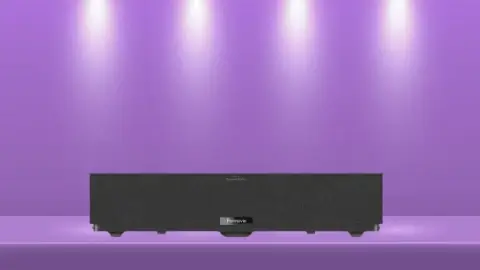 The Formovie Theater projector impresses with its advanced color processing, boasting 10-bit color and 107% Rec.2020 color gamut coverage, delivering vibrant, true-to-life colors for an immersive viewing experience. The inbuilt speakers designed by Bowers & Wilkins engineers offer high-quality audio output that enhances the viewing experience significantly. Its Android TV 11.0 operating system is user-friendly and provides plenty of entertainment options right at your fingertips. Its ability to project larger images and the Auto Low Latency mode make it a great choice for big-screen enthusiasts and gamers. However, the fan noise and slight issues with the remote might need addressing.
The Formovie Theater projector impresses with its advanced color processing, boasting 10-bit color and 107% Rec.2020 color gamut coverage, delivering vibrant, true-to-life colors for an immersive viewing experience. The inbuilt speakers designed by Bowers & Wilkins engineers offer high-quality audio output that enhances the viewing experience significantly. Its Android TV 11.0 operating system is user-friendly and provides plenty of entertainment options right at your fingertips. Its ability to project larger images and the Auto Low Latency mode make it a great choice for big-screen enthusiasts and gamers. However, the fan noise and slight issues with the remote might need addressing.
Pros
- Advanced 10-bit color processing for vibrant images.
- Larger image projection up to 150.09″.
- Bowers & Wilkins engineered high-quality speakers.
- Android TV 11.0 and streaming apps supported.
- Auto Low Latency mode for smoother gaming.
Cons
- Notable fan noise during operation.
- Issues encountered with the remote control.
Optoma CinemaX D2 vs Formovie Theater: Features Comparison
Design and Build
The Optoma CinemaX D2 measures 5.12″ x 22.68″ x 15.08″ and weighs 18.5 lbs. It has a sturdy, solid build quality and features a pleasing aesthetic. The Formovie Theater, in comparison, is slightly heavier at 21.6 lbs and measures 4.23″ x 21.65″ x 13.74″. While both projectors are compact, their weight might be a factor if portability is a priority.
One of our customers expressed displeasure with the fixed front legs on the Optoma CinemaX D2, as they found them inconvenient. The Formovie Theater, on the other hand, does not seem to have similar complaints.
Brightness and Contrast
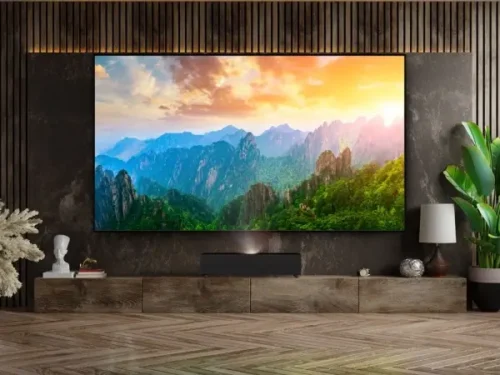
The Optoma CinemaX D2 boasts a brightness of 3,000 ANSI Lumens while the Formovie Theater clocks in slightly lower at 2,800 ANSI Lumens. In real-life scenarios, the extra brightness in the CinemaX D2 enhances visibility, particularly in rooms with ambient light.
Regarding contrast, the Formovie Theater offers a 3,000:1 contrast ratio. In contrast, the Optoma CinemaX D2 doesn’t provide a specific contrast ratio but claims a 1,800,000:1 dynamic contrast ratio. The Formovie does provide deep blacks, yet we found the Optoma CinemaX D2 to have a more superior contrast with striking darks and brights.
Resolution and Color Processing

Both projectors provide true 4K UHD resolution (3840×2160), ensuring that your movies look crisp and immersive. But when it comes to color processing, the Formovie Theater takes the edge with its 10-bit color processing and coverage of 107% of the Rec.2020 color gamut. The Optoma CinemaX D2 does a good job with the Rec.709 color gamut but doesn’t match the Formovie’s broader color range.
Lamp Life and Technology
The Optoma CinemaX D2 employs Laser Phosphor technology, guaranteeing a lamp life of 30,000 hours, outperforming the Formovie Theater’s RGB Laser with 20,000 hours. This extended lamp life makes the CinemaX D2 a cost-effective choice in the long run.
Input Lag and Gaming
With an input lag of 16ms at 4K/60 and 4ms at 1080p/240, the Optoma CinemaX D2 is quite suitable for gamers. However, we did encounter a customer review indicating a slight lag. On the other hand, the Formovie Theater does not specify its input lag but features an Auto Low Latency mode.
Audio Performance

The Formovie Theater has 15.0 Watts × 2 speakers, outperforming the Optoma CinemaX D2’s 10.0 Watts × 2 speakers. The Formovie is powered by speakers designed by Bowers & Wilkins engineers, offering a pleasing, clear, and balanced audio output. The Optoma CinemaX D2’s audio output is adequate but not exceptional.
Operating System and Smart Features
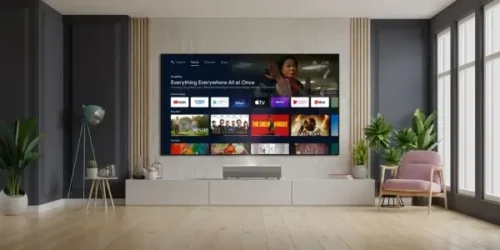
The Optoma CinemaX D2 runs on Android TV, providing access to over 400,000+ movies, TV shows, live sports, and music across streaming services. The Google Assistant integration allows you to control your content with voice commands, contributing to a convenient user experience.
On the other hand, the Formovie Theater runs on Android TV 11.0 and comes with Google Assistant Far-field Voice for easy control. The device also supports several streaming apps, making it a great all-in-one entertainment unit.
, providing access to over 400,000+ movies, TV shows, live sports, and music across streaming services. The Google Assistant integration allows you to control your content with voice commands, contributing to a convenient user experience.
On the other hand, the Formovie Theater runs on Android TV 11.0 and comes with Google Assistant Far-field Voice for easy control. The device also supports several streaming apps, making it a great all-in-one entertainment unit.
Throw Distance and Image Size
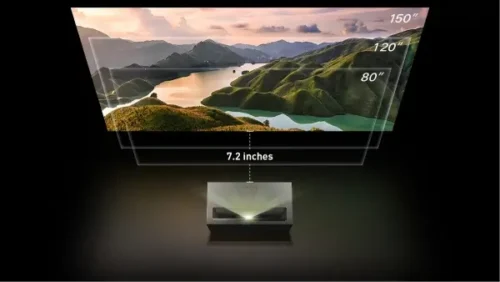
The throw distance of the Optoma CinemaX D2 ranges from 1.5′ to 2.2′ while the Formovie Theater has a throw distance between 1.4′ to 2.5′. Both offer a comparable range, but the Formovie Theater can project larger images from 79.77″ to 150.09″, compared to the CinemaX D2’s 84.81″ to 120.06″. In our tests, both projectors delivered excellent picture quality across a range of sizes.
Remote Control and Interface
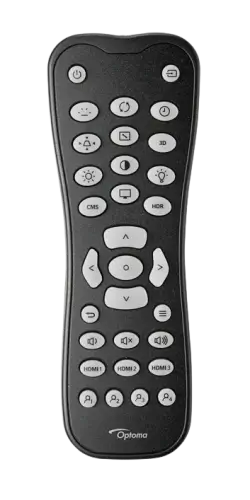
Our tests showed some challenges with both remotes. One customer reported that the Optoma CinemaX D2’s remote won’t charge and lacks buttons on the projector for backup. Another customer faced issues with the Formovie Theater’s remote on the second day of use but was able to resolve it with the help of a USB mouse and keyboard. Both projectors would benefit from improvements in this area.
HDR Compatibility and Performance
Both projectors support HDR content, though with different standards. The Optoma CinemaX D2 supports HDR10, while the Formovie Theater claims to support HDR10+. However, a customer review noted issues with the latter’s HDR10+ capability, suggesting it might only be decoding to HDR10.
Final Verdict
After extensive testing and review analysis, both the Optoma CinemaX D2 and the Formovie Theater have proven themselves as premium-quality devices. Each has its own unique strengths: Optoma CinemaX D2 excels in brightness, longer lamp life, and gaming performance, while Formovie Theater shines with superior color processing, strong audio output, and a larger image size.
However, when considering an all-around performance balance, we found the Optoma CinemaX D2 to be the better pick. Its comprehensive set of features catered more effectively to a variety of viewing scenarios. Check the Latest Price on ProjectorScreen.com Now! Remember, the ideal projector for you will ultimately depend on your specific needs and viewing preferences. We trust this detailed comparison will be of great help in your decision-making process. Happy viewing!
Related Comparisons and Guides:
- Optoma Cinemax D2 vs D2 Smart Comparison
- Optoma CinemaX D2 vs P2 Side by Side
- Epson LS800 vs Formovie Theater

